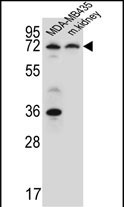P2RX7 Antibody (C-term)
Affinity Purified Rabbit Polyclonal Antibody (Pab)
- SPECIFICATION
- CITATIONS: 1
- PROTOCOLS
- BACKGROUND

Application
| IHC-P, WB, E |
|---|---|
| Primary Accession | Q99572 |
| Other Accession | NP_002553.2 |
| Reactivity | Human, Mouse |
| Host | Rabbit |
| Clonality | Polyclonal |
| Isotype | Rabbit IgG |
| Calculated MW | 68585 Da |
| Antigen Region | 563-592 aa |
| Gene ID | 5027 |
|---|---|
| Other Names | P2X purinoceptor 7, P2X7, ATP receptor, P2Z receptor, Purinergic receptor, P2RX7 |
| Target/Specificity | This P2RX7 antibody is generated from rabbits immunized with a KLH conjugated synthetic peptide between 563-592 amino acids of human P2RX7. |
| Dilution | IHC-P~~1:50~100 WB~~1:1000 E~~Use at an assay dependent concentration. |
| Format | Purified polyclonal antibody supplied in PBS with 0.09% (W/V) sodium azide. This antibody is purified through a protein A column, followed by peptide affinity purification. |
| Storage | Maintain refrigerated at 2-8°C for up to 2 weeks. For long term storage store at -20°C in small aliquots to prevent freeze-thaw cycles. |
| Precautions | P2RX7 Antibody (C-term) is for research use only and not for use in diagnostic or therapeutic procedures. |
| Name | P2RX7 |
|---|---|
| Function | ATP-gated nonselective transmembrane cation channel that requires high millimolar concentrations of ATP for activation (PubMed:17483156, PubMed:25281740, PubMed:9038151). Upon ATP binding, it rapidly opens to allow the influx of small cations Na(+) and Ca(2+), and the K(+) efflux (PubMed:17483156, PubMed:20453110, PubMed:28235784, PubMed:39262850). Also has the ability to form a large pore in the cell membrane, allowing the passage of large cationic molecules (PubMed:17483156). In microglia, may mediate NADPH transport across the plasma membrane (PubMed:39142135). In immune cells, P2RX7 acts as a molecular sensor in pathological inflammatory states by detecting and responding to high local concentrations of extracellar ATP. In microglial cells, P2RX7 activation leads to the release of pro- inflammatory cytokines, such as IL-1beta and IL-18, through the activation of the NLRP3 inflammasome and caspase-1 (PubMed:26877061). Cooperates with KCNK6 to activate NLRP3 inflammasome (By similarity). Activates death pathways leading to apoptosis and autophagy (PubMed:21821797, PubMed:23303206, PubMed:28326637). Activates death pathways leading to pyroptosis (By similarity). |
| Cellular Location | Cell membrane; Multi-pass membrane protein {ECO:0000250|UniProtKB:Q64663} |
| Tissue Location | Widely expressed with highest levels in brain and immune tissues. |

Provided below are standard protocols that you may find useful for product applications.
Background
P2RX7 belongs to the family of purinoceptors for ATP. This receptor functions as a ligand-gated ion channel and is responsible for ATP-dependent lysis of macrophages through the formation of membrane pores permeable to large molecules. Activation of this nuclear receptor by ATP in the cytoplasm may be a mechanism by which cellular activity can be coupled to changes in gene expression.
References
Kim, M., et al. EMBO J. 20(22):6347-6358(2001)
Gartland, A., et al. J. Bone Miner. Res. 16(5):846-856(2001)
Gu, B.J., et al. J. Biol. Chem. 276(14):11135-11142(2001)
Buell, G.N., et al. Recept. Channels 5(6):347-354(1998)
Rassendren, F., et al. J. Biol. Chem. 272(9):5482-5486(1997)
If you have used an Abcepta product and would like to share how it has performed, please click on the "Submit Review" button and provide the requested information. Our staff will examine and post your review and contact you if needed.
If you have any additional inquiries please email technical services at tech@abcepta.com.














 Foundational characteristics of cancer include proliferation, angiogenesis, migration, evasion of apoptosis, and cellular immortality. Find key markers for these cellular processes and antibodies to detect them.
Foundational characteristics of cancer include proliferation, angiogenesis, migration, evasion of apoptosis, and cellular immortality. Find key markers for these cellular processes and antibodies to detect them. The SUMOplot™ Analysis Program predicts and scores sumoylation sites in your protein. SUMOylation is a post-translational modification involved in various cellular processes, such as nuclear-cytosolic transport, transcriptional regulation, apoptosis, protein stability, response to stress, and progression through the cell cycle.
The SUMOplot™ Analysis Program predicts and scores sumoylation sites in your protein. SUMOylation is a post-translational modification involved in various cellular processes, such as nuclear-cytosolic transport, transcriptional regulation, apoptosis, protein stability, response to stress, and progression through the cell cycle. The Autophagy Receptor Motif Plotter predicts and scores autophagy receptor binding sites in your protein. Identifying proteins connected to this pathway is critical to understanding the role of autophagy in physiological as well as pathological processes such as development, differentiation, neurodegenerative diseases, stress, infection, and cancer.
The Autophagy Receptor Motif Plotter predicts and scores autophagy receptor binding sites in your protein. Identifying proteins connected to this pathway is critical to understanding the role of autophagy in physiological as well as pathological processes such as development, differentiation, neurodegenerative diseases, stress, infection, and cancer.


